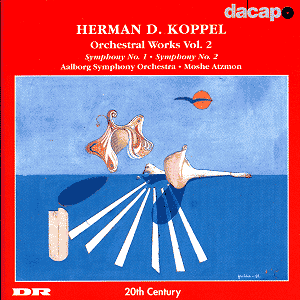Here are two three movement symphonies from the
Danish composer Herman D. Koppel. Koppel wrote seven symphonies
between 1930 and 1961. The first two shared a common fate for
many years - rather like the first two symphonies by William Schuman
and David Diamond. They were banned from performance by composer
edict. The composer's prohibition was put in place from 1943,
the year of the appearance of the Third Symphony written in exile
in Sweden. All the same the composer did not renumber the symphonies.
The First Symphony he wrote during travels
from Denmark to Germany and back. There are no illusions, smoke
or mirrors. The music is strongly though not exclusively in debt
to Nielsen (especially in the two outer movements) whose example
he held in the strongest affection. The Nielsen symphonies most
closely linked are the symphonies 2 and 5. Contemporary reaction
after a 1931 premiere under the baton of Emil Telmányi
was bitter 'every single theme was by Nielsen ... except one that
was by Fini Henriques'. This is far too harsh a judgement to be
permanent. This music has individuality too as in the long and
languid yet unsentimental Adagio which would go well in
any concert context. While the composer banned further performances
it is interesting that he did not destroy the piece.
The Second Symphony is the first of his
three wartime symphonies which was written in Denmark three years
into the Nazi occupation. It was finished some six months before
the Holocaust programme drove him from his homeland to neutral
Sweden. The music of the first movement (Allegro tranquillo)
is of long lyrically singing lines. The theme is of the highest
quality with presentiments of Vaughan Williams' Sixth Symphony
from six years later and of Tubin's Third and Fourth symphonies.
It also has the steady-pulsed propulsion of the Moeran Symphony.
The second movement andante is less florid - more ambivalent
in mood at least until we get to the idyllic dialogue of horn
and strings at 4.30 - half Copland, half Moeran. The finale is
the longest movement (17.03) in this very substantial symphony.
There is a smattering of Nielsen here but Koppel is now in more
confident flower. The fugal writing at 6.25 passingly suggests
the heady flight of strings in Tippett's Concerto for Double
String Orchestra. The work was conducted at its premiere by
Thomas Jensen at the Tivoli. The composer withdrew the piece after
being dissatisfied with the way it sounded at the premiere although
from this perspective it is the finale that leaves one with doubts.
Two symphonies withdrawn by Koppel; one with
strong obeisance to Nielsen; the other much more individual and
striking - weaker only in the finale and then only intermittently.
This disc, with good notes by Jens Cornelius,
is a companion to Vol. 1 Dacapo 8.224135.
Rob Barnett
See also review
by John Phillips
